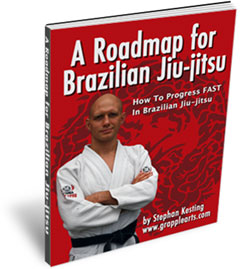Stephan’s note: This is the transcript of an interview I did with noted Brazilian jiu-jitsu black belt, über-competitor and teacher Ryan Hall.
 |
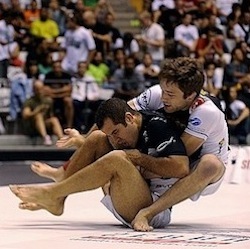 |
To listen to this conversation you could press play on the embedded audio player below, but then you might miss out on future episodes, wouldn’t you?
So the best thing to do is to subscribe to The Strenuous Life Podcast using the podcast player that you almost certainly already have on your phone!
(For example, if you have an iPhone then it’s the purple app with the antenna-like thing in it. Just click the Apple Podcasts link below and it should open up that app for you.)
Here are the links to find the podcast on various players (This one is episode 09)…
- Apple Podcasts (the purple app on your iPhone)
- Google Podcasts (the new google podcast app)
- Spotify (it’s free)
- Stitcher,
- Soundcloud,
- Google Play
Or you can listen here:
RYAN HALL INTERVIEW
Stephan: Hello everybody, Stephan Kesting from grapplearts.com here. Today, I’ve got Ryan Hall on the line. Ryan is a super accomplished and very prolific competitor. He’s competed all over the world in hundreds of tournaments and he’s known for a variety of things including certain exotic guard positions, being laser-focused on certain submissions, and also for having a very rapidly evolving game.
We’re going to start off the interview, Ryan, by talking about your competitive background. How many tournaments have you actually competed in?
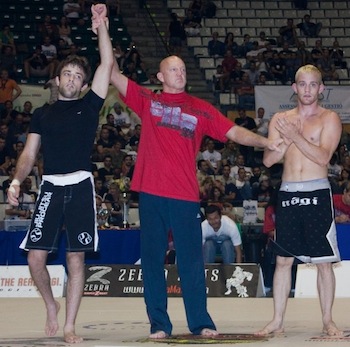 Ryan: I have a record of every single match and every single opponent that I’ve ever competed against. Almost every single name, actually, from all the way back to white belt. So it’s kind of silly but probably, I would say in the neighborhood of 200 tournaments. I think I’ve had somewhere in the neighborhood of 350 to 400 competitive matches. I’ve been able to get around and fortunate to compete a lot, I guess.
Ryan: I have a record of every single match and every single opponent that I’ve ever competed against. Almost every single name, actually, from all the way back to white belt. So it’s kind of silly but probably, I would say in the neighborhood of 200 tournaments. I think I’ve had somewhere in the neighborhood of 350 to 400 competitive matches. I’ve been able to get around and fortunate to compete a lot, I guess.
Stephan: And of late you’ve also been singled out for grappling super fights, or one-off matches. Is that correct?
Ryan: Yeah, it is. I’ve been fortunate enough lately to be able to compete against some pretty tough opponents. Some fights at the Grapplers’ Quest, UFC Fan Expo, and here and there. I’ve actually been doing super fights since I was a brand new purple belt.
I guess I’ve been reasonably successful; there’s a lot of really tough guys to compete against. Particularly as you get up toward black belt, at least in the United States, it becomes increasingly difficult to go to a tournament and have more than maybe 1 or 2 matches. As a result, a lot of times, I think promoters find it more in their interest to make sure that they get the 2 guys that they want to compete and hopefully generate some interest. I was fortunate enough to be picked out for some of those.
Stephan: Cool. Can you just blow your own horn here for a second and talk about some of the medals and titles that you’ve got on your trophy shelf? What does it look like? What are some of the names I would recognize?
Ryan: At purple belt back in 2007, 2008, I was able to win the No-Gi Worlds, Lightweight division at purple belt. I won the World Championships with the gi as purple belt, again in the Lightweight Division. I won the European Championships as purple belt and ended up as 3rd in the Brazilian Nationals, the Brasileiro, also at purple.
As soon as I got my brown belt I had a pretty serious injury and had to have 3 surgeries. I didn’t even know if I was going to be able to continue competing, and that’s when I opened up my academy.
But I was able to compete. I had been out for about 8 months, then was able to train for 2 months and went back to the World Championships, this time as a brown belt. I ended up with 3rd; I lost in the semifinals, 6 to 4, to a really tough guy named Zak Maxwell.
I won the Abu Dhabi Trials that year as well, earning the opportunity to compete against the toughest no-gi guys in the world. I was fortunate enough to end up placing 3rd in the Abu Dhabi Competition itself.
I’ve been able to win a fair number of super fights: the UFC Fan Expo,and so on. I’m something like 15 and 2 in super fights, mostly against black belts. But my first one, and this was kind of meaningful because this is the first important match I ever won, was against a guy that I really respect a lot named Renato Tavares. This was on October 28th, 2006 at a NAGA event in Miami, and I was able to beat Renato Tavares 3 to 2. That was the first super fight I ever won.
So I guess that’s kind of the more major stuff. I’ve also won some of the open tournaments as a black belt like the Chicago Open where I won in middleweight and the Absolute division (closed with Rodrigo “Comprido” Medeiros). Also the Miami Open, Houston Open, so I’ve gotten around but I don’t have any major titles with the gi in black belt as of yet. I was able to win the World Pro Trials in Montreal, but I’m still trying to do my best and see how I can do better in the future.
Stephan: So now that you’ve got all of this competitive experience under your belt, are you still nervous when you compete and were you ever nervous when you competed?
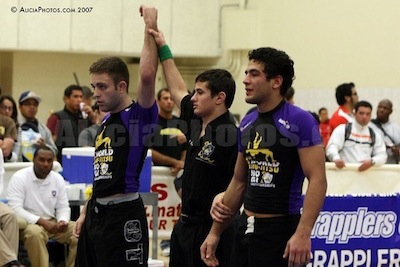 Ryan: I don’t know if nervous is the right word… I’ve played with a lot of different mental approaches over time, trying to learn what works best for me. And I believe that everyone can find their own mental niche, or state of mind that they need to be in.
Ryan: I don’t know if nervous is the right word… I’ve played with a lot of different mental approaches over time, trying to learn what works best for me. And I believe that everyone can find their own mental niche, or state of mind that they need to be in.
I remember in the beginning when I first started, I would try to get all amped up and almost… maybe angry is not the right word… but a little ticked off, I guess, before a match. I was like, “Oh man, I’ve got to fight someone and so I’ve got to go and get upset…”
That worked for a little while, but then it kind of petered out for me, and I realized that that’s maybe not the right way for me because that’s not who I am. I’m not a super crazy, aggressive person, so maybe that’s not the right way for me.
Then I started trying to take a nap, literally up until 2 minutes before my match. I would just fall asleep and then compete: I’d walk out almost like a zombie sometimes, extremely relaxed, which was working for a while: it kept me very calm, and I’ve never had that much trouble being clear-headed during matches because, again, I was not just focusing on winning and losing, which are things that are ultimately outside of my control, but really more on performing well, trying to focus on my technique and doing my own personal best and then, hopefully, that will be enough.
I guess that worked for a while. I’ve read a lot of books about sports psychology. I’m no expert by any means, but I’ve been able to take a look at my approach and now I’m trying to find the right balance emotional content; getting yourself amped up to the point where you’re able to be effective and perform your best but it’s not overwhelming you, because I’ve seen that occur a lot.
If you look in the bullpen at the World Championships, you’ll see all kinds of people. You’ll see calm, you’ll see intense, you’ll see all types, and you’ll see people who let the moment get to them and they almost look entirely drained.
What I’ve read and what I’ve understood is that the more skilled and higher level you are as an athlete, the less of a danger it is to become infused emotionally because it won’t affect your technique as much as it might. If, on the other hand, I was a bit more of an amateur athlete, then any type of outside stimulus, like being frustrated, angry, or nervous could really impact me.
So, as I’ve gotten a little bit more experience, the nerves have gone away. And I wouldn’t call it nervousness anymore. I’d almost call it ‘being excited,’ ‘being ready to compete’ and looking forward to the challenge, as opposed to “oh, I’m going to beat this guy up.” That’s never really been my thing, I guess.
Stephan: The Sports Psychology books that I read talk about the ‘optimal state of arousal.’ This is perhaps a poor choice of words in our context, but is this what you’re talking about?
Ryan: That’s exactly what I was talking about and that’s the specific phrase. And the optimal state of arousal, as I’ve been able to understand it, is not only different for every person but highly different for every sport.
For instance, a lineman in football would want to be in an entirely different mental state than, say, the quarterback. It’s just an entirely different job, and an entirely different mental approach.
And Jiu-Jitsu is such a highly technical exercise, as opposed to, say, sprinting. Sprinting is also highly technical, of course, but a little bit more explosive, starting and finishing very quickly.
It’s all about finding the right spot where you’re able to be up and sharp but also mentally aware and able to react quickly to different situations. And so that’s exactly the phrase that I would use.
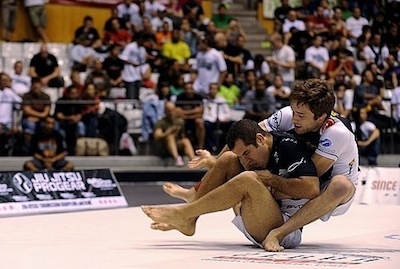
Ryan: I’ve been on the wrong end of both of those, actually, and I still am every now and then. There have been certain tournaments where win or lose, I still don’t really feel like I performed well. I’m not like “oh man, the other guy was really tough but I somehow just expected to walk through him.” Instead it was more like, “man, I just didn’t really feel sharp,” or felt like I was too amped up, or just felt not into it. And that can be for a variety of reasons, but even now, I find myself on both ends of that.
And then, when everything comes together and you have a great performance, it’s usually when you find that optimal level of arousal, not only for the sport but for the moment and for that day. Everything seems to be clicking. And when I’ve been able to find and maintain that state of mind once then I’m able to find it again. And that’s one of the big things that I think that constant competition gives us.
For instance, if I compete only once every 6 months, I kind of lose touch with the proper frame of mind. It’s easy to have all these other things going on, these little voices in your head telling you what you need to be doing. But if you’re competing all the time, not only will you be getting experience, but you’ll be getting experience psychologically preparing yourself to perform at your best, and I think that’s absolutely critical.
Stephan: So in order to get ready for a competition, you should enter a competition.
Ryan: Yeah, it’s kind of a weird Catch-22…
Stephan: So let’s move a little bit into the technical side of things, Ryan. Let’s talk about the guard position. It seems to be that a lot of people know you, either through your videos or by watching you compete, for the guard position, such as the inverted guard, the deep half guard, the 50-50.
Can you talk a little bit about your guard game initially, how it evolved and where your guard game is right now?
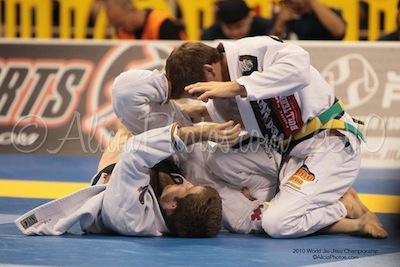 Ryan: Well, initially, all I played was the closed guard. I think I won my last 16 matches as a white belt by submission from triangles and arm locks and it was about getting the closed guard and then going. Closed guard felt like a comfortable place for me because even against stronger players, not physically stronger but more skilled, more technical, more experienced, I thought that if I could get myself to the closed guard, I can at least hold on for now.
Ryan: Well, initially, all I played was the closed guard. I think I won my last 16 matches as a white belt by submission from triangles and arm locks and it was about getting the closed guard and then going. Closed guard felt like a comfortable place for me because even against stronger players, not physically stronger but more skilled, more technical, more experienced, I thought that if I could get myself to the closed guard, I can at least hold on for now.
So I started out with the closed guard, and then eventually, I was like, “man, people are kind of getting wise to this…” When I was a blue belt I was competing so often that people were starting to pay attention a little bit. It wasn’t that I was anybody at the time, they were paying attention because there was only one thing that I was really doing.
What I started adjusting to was pulling upside-down guard, because I found out that I was hyper-flexible in a few ranges of motion. I know very little about flexibility, by the way, I just happened to discover that. And I didn’t mind being upside-down, didn’t mind being compressed by really big people. I would go upside-down and then I would shoot a triangle at them. I would either, A) hit the triangle or, B) if I missed the triangle and they postured up, I would land myself in closed guard and get me back to my area of comfort.
Eventually, people started giving me a really hard time. They started standing up when I would invert on them. I’d shoot triangles at them and I’d get it every now and then, even when they were standing fully upright, but against the better and more experienced guys, that was really tough.
So the natural progression was when they stood up all the way up, I would weave my leg through theirs, end up in the 50-50 guard position and start to go after them with foot locks.
I really didn’t start sweeping anyone until three quarters of the way through purple belt. I think I had something like 120 or 130 matches as a blue belt, I couldn’t have scored more than 20 or 30 points throughout the entire course of that. Anytime I scored, it was mostly accidental.
Stephan: And most of your wins came from the triangle choke. Is that correct?
 Ryan: Most of them came from triangle. Up until brown belt something like 98% of my wins were by submission. This was not necessarily because I was going after submissions, but rather because I literally didn’t try to do anything positional, which I don’t think was ideal. I don’t really blame anyone for that – it’s just kind of what I was doing at that time and it was working fairly well.
Ryan: Most of them came from triangle. Up until brown belt something like 98% of my wins were by submission. This was not necessarily because I was going after submissions, but rather because I literally didn’t try to do anything positional, which I don’t think was ideal. I don’t really blame anyone for that – it’s just kind of what I was doing at that time and it was working fairly well.
I got to purple belt relatively quickly (just over 2 years) and I was a purple belt for a relatively short time (1 year, 10 months). I wasn’t one of those guys who has been in for 8 years and is still a purple belt and, as a result, has a little more of a robust game.
Because I was moving up the ranks relatively quickly and constantly facing opposition significantly more experienced than me, if I wanted to be successful I had pull them into my area of strength. Into the area where I felt that I had a chance to win, and that was almost always the guard.
Stephan: Now that’s your development, but not everybody who’s listening to this have your specific set of attributes, your strengths, and – I suppose – your weaknesses…
What advice could you give to people who are trying to put together a coherent guard game so they can deal with most situations? How do you know what kind of guards you need for your kind of body and your kind of game?
Ryan: I think it’s a great question, Stephan, and again, I’ll do my best to answer. An effective guard game is one that covers all of our ranges.
I like to use analogies a lot and I feel that it helps me understand jiujitsu and whatever I can see in the world, I guess. When I teach I try to use analogies. I’ll try to figure out something that someone I’m talking to has a depth of experience in, and then I’ll try to relate Jiu-Jitsu to that.
For instance, if I go to Oscar de la Hoya or say Manny Pacquiao and ask “what do you think of the straight right hand” they’d look at me like I have a second head on my shoulders. They’d be like “what do you mean what do I think? I use it when it’s the right tool. I don’t when it isn’t.”
Or imagine, you’re a soldier. You have a weapon with a scope for when I’m 300 yards away from you. You also have a short barrel weapon you can turn corners with and operate at close quarters, and if you get really tight, you have a knife. And if even your knife goes away, then you have your hands…
So the way that I would describe an effective guard game, as I understand it, is that basically I need to be able to address each range. You may be far from me, you may be very, very close to me and you may be kind of in the mid-range.
A lot of times, what people will do, is they’ll start to develop one guard. But let’s say there’s a blue belt or a purple belt that I find has a really tough half guard; if I can stay in the range where they’re not able to employ their favorite tool, then they’re going to have a hell of a time.
For instance, there’s all kinds of different passes. I can pass you close, I can pass you far, I can pass you with motion, and I can pass you with pressure… Each one is an appropriate tool for a specific time.
The way I would describe Jiu-Jitsu is that it is a toolbox and you’re going to use the appropriate tool to deal with someone who has my build – lanky and flexible – and then there will be an entirely different tool appropriate for dealing with someone with Marcelo Garcia’s build, which is a little shorter and stockier (all skill aside), because obviously there are physical things that I can do that he can’t and physically things that he can do that I can’t. As a result, you should approach us differently, regardless of our specific games and of our skill levels.
Half guard has always been useful for me because I can handle the situation when the guy’s very, very close. The 50-50 is even closer range than that, so I like that as well. I like to have a mid-range style of guard, like the de la Riva, and then when you start to move away from me, I’ll come to my seated guard or, for someone like Michael Langhi, you could use the spider guard instead.
But people don’t attempt to employ a hammer when the screwdriver is the proper tool. If I’m attempting to develop my guard, then I need to be effective from ranges A, B and C. I not only need to know the concepts and ideas behind my movements but also what are the things that go in this person’s head? How are they going to evaluate me? Because if I try to pressure pass an experienced fighter’s spider guard that’s very difficult. If I try to run around your seated guard without getting you out of position then, again, that can be very, very difficult.
I feel that, in the lower levels of jiujitsu, like white, blue, purple belt, there’s all kinds of things that work or feel like they work because the other player has gaps in their game.
In the past there were all kinds of things I was able to get away with, or even still get away with against a certain level of black belt… But then against an elite level guy you’re like, “Oh, there’s not 5 valid moves here, maybe there’s only 1 or 2,” and it’s difficult to see that sometimes if you’re not constantly faced with problems of that level.
So I would say try to develop a distance guard. Try to develop something for when the guy tries to run around you. Try to develop something for when they’re trying to crush you. Know how to utilize your guards and how to transition between them., and then your guard should grow organically on its own.
One can’t always look at an elite level player and say “I want to do exactly what this guy’s doing,” because there are all types of factors – height, width, strength, flexibility – that make moves fit me or not fit me, and also fit me or not fit me based on my opponent at that time.
I guess it’s difficult to give concrete advice but the idea is that you should try and have a game plan: you need to understand what the possibilities are, and try to have an answer for most of the situations.
 Stephan: Okay, let’s just talk very quickly about one specific position, the 50-50 guard. I’ve seen bits and pieces of your DVD series on the 50-50 guard, which was mostly without the gi. In those DVDs you concentrate quite heavily on the heel hook, the reverse heel hook and the whole foot lock game…
Stephan: Okay, let’s just talk very quickly about one specific position, the 50-50 guard. I’ve seen bits and pieces of your DVD series on the 50-50 guard, which was mostly without the gi. In those DVDs you concentrate quite heavily on the heel hook, the reverse heel hook and the whole foot lock game…
Can you talk a little bit about the 50-50 in the context of the gi, where very often it turns into a stalling position? This relates back to what we were talking about just getting up a couple of points and then stalling for the rest of the match.
Ryan: Yeah, for whatever small role I’ve had in popularizing the 50-50, I’d like to apologize to the grappling world because it is hideous to watch matches where people just lock themselves in there and refuse to move (laughing)! It’s absolutely awful and it is everything that people complain about it being…
As far as stalling with the gi on… it’s frustrating because with the gi on, you can latch onto me in such a way that it can be difficult to move and then it’s difficult for the referee to figure out whom exactly is doing the stalling.
In my mind, Jiu-Jitsu needs a better stalling call in general. The 50-50 is kind of en vogue at the moment for stalling and doing nothing, but that’s nothing new, really. Plenty of positions can be used to hold the fight, but something that might go a long way towards fixing the 50/50 problem is to stop giving points for a sweep if I just rock my way up to the top (staying locked in 50/50). If I don’t disengage myself from the position, then I don’t believe that I should be given points because otherwise there’s no incentive to do it. If you look at some of the elite guys who are incredible with the 50-50 (I think there’s only a handful, but a lot of people try it), it’s not as if they can’t sweep, it’s just that there’s no incentive to do it. Why risk losing position in a major tournament?
I wish they would develop a stronger stalling call in BJJ compeition. And if you want to talk about making Jiu-Jitsu more effective for MMA, they should give points for escapes and for getting up off of the ground, because the onus should be on me to hold you on the ground. Let’s say I fight Manny Pacquiao, if we stay on our feet for any length of time, I will be headless, so I have to get him down. And once I get him down, my number one concern is not to submit him! Instead I’m thinking “Jesus Christ, make sure he doesn’t get back up because that’ll be the end of me…”
Stephan: Exactly.
Ryan: In my opinion, one thing that makes wrestling so effective is that they give points for escaping from the bottom to get back to the feet. I think it’s critical.
And a stalling call would be nice. But there would be downsides to that as well, because if there’s a stalling call every 4 seconds, it would turn into a hyper-explosive athletic sport, which I think is great in some regards but it really, really narrows it down too…
Stephan: The injury rates would go through the roof…
Ryan: No doubt about it. And you’re also not going to see little guys beating big guys in a sport where you to move every 4 seconds. It’s just not realistic, and maybe that’s the way that it needs to be. I’m not sure.
I’m not saying what’s better or worse, but I would prefer to see the current state of things change a little bit, both with the stalling calls and absolutely with the 50-50 guard. I try not to stall from the 50-50. In fact, just on principle I don’t stall from there, in fact I’d rather lose than do that. But it got atrocious and I apologize for that (laughing).
Stephan: You heard it here first, people!
Let’s move on to another technical area that you’re particularly known for, and that’s the triangle choke. You’ve finished an ungodly number of people with the triangle choke, especially earlier in your game.
What are your top 3 tips for getting and finishing triangle chokes that people who are working on that attack can use?
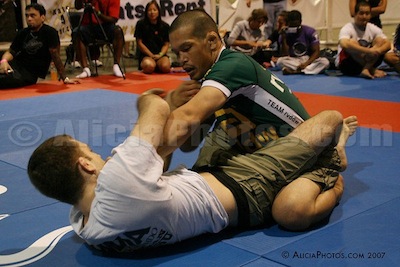 Ryan: One big thing is creating a favorable angle. If you’re attacking me, then try to get so so that you face me when I’m not facing you. Anytime that we go head to head my attributes are lining up against yours, and I’m having to hope that I’m stronger, faster or more flexible. I’d have some sort of physical edge over you to allow me to be successful.
Ryan: One big thing is creating a favorable angle. If you’re attacking me, then try to get so so that you face me when I’m not facing you. Anytime that we go head to head my attributes are lining up against yours, and I’m having to hope that I’m stronger, faster or more flexible. I’d have some sort of physical edge over you to allow me to be successful.
Now, in the context of a competition, if that’s where my edge lies, if I have a physical advantage, then I’m going to press that advantage because the goal is to win. Well, to anyone who’s listening, the goal is not just to win in the competition. For instance, let’s say I go to a tough tournament, like a Grappler’s Quest, which I’ve won a stack of times, now the goal is no longer solely to win. The goal is to improve so that I can develop something I’ll be able to use at ADCC or the Mundial, Pan, etc.
For instance, when Roger Gracie comes to the World Championships, I have this sneaking suspicion that because he’s gotten gold so many times, it’s no longer only about winning, even at the premier gi tournament in the world. Instead it’s about the quality of his win. It’s about what he’s doing. Is he fighting Jiu-Jitsu the way that he wants to fight it? I think that’s why you’ll see him fighting judo with people when that’s not the strength of his game.
early in your career, you’ll feel like you’ll want to win every single match in any way you can. But as you evolve you might say that you want to win in a specific way. I want to win with good jiu-jitsu, or I want to win with positional control, or I want to make sure that I’m not using my physical advantages or experience advantages to win.
I think that’ll go a long way towards making sure that you don’t plateau as you compete, which I know has been a problem for a lot of people, and a problem for me as well from time to time.
But if you want to land a triangle, then it’s good to get off to a favorable angle where you’re facing me and I’m not facing you. I could be an 8 out of 10 in terms of strength, athleticism and explosiveness, and you could be a 4 out of 10, but once you start to get out of my kind of direct line of sight right in front of me and a little bit off to the side, I no longer have that physical advantage over you. So you’re going to be able to bully me from there, or I’m going to try to square back up to you and that makes me predictable. So either, a) the status quo will remain and you’ll win, or b) I’m predictable so you’ll probably win anyway.
Stephan: Well, let’s take this all from the high level to the concrete level. You said you’re heading up for your training camp now?
Ryan: Yes.
Stephan: So what are your next 6 weeks going to look like? Obviously you’re going to be training with Marcelo and with other people, but do you do any conditioning – strength training, endurance training – on top of all that actual sparring? And what’s your ratio of training to sparring, and drilling to sparring?
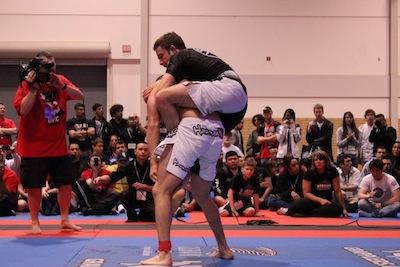 Ryan: Ordinarily I do a lot of drilling, and I feel like when I don’t drill a lot I become pretty sloppy; I notice holes in my game. I feel like it’s very important. I feel that it has been able to allow me to be reasonably successful in spite of pretty much having no one of a really high level to train with for a very, very long time.
Ryan: Ordinarily I do a lot of drilling, and I feel like when I don’t drill a lot I become pretty sloppy; I notice holes in my game. I feel like it’s very important. I feel that it has been able to allow me to be reasonably successful in spite of pretty much having no one of a really high level to train with for a very, very long time.
I’ve been able to structure my training so that everything is goal-oriented instead of just beating the crap of each other one day. Instead we get our drilling rounds in. And sometimes it’s time to roll easy so we’re playing around and finding new movements, and seeing what’s what. Other times it’s time to go super hard. And then we also have the strength and conditioning aspect as well.
We make sure that each step of the training isn’t just random. It’s not just thrown in together, like “oh, we just beat the shit out of each other say all the time, because that’s what training is.” If something makes sense in the context of a greater plan, then that’s what we do for that day or that week, or whatever.
But it has to all be goal-oriented and system-oriented, so if there’s a problem or if you get a result you don’t like, then you can say, “alright, where’s the hole in the system?” If there is no system and I’d get a result I don’t like but there’s no feedback loop, then I’m left curious and wondering what the heck to fix.
When it comes to strength and conditioning, ordinarily, I do a lot. I’ll be lifting 3, 4 days a week. One of the students at my academy is a very, very good strength and conditioning coach and he prepared me for Abu Dhabi last time. I felt great. I felt stronger than ever before. He helped me for the Worlds in 2009 as well.
For this ADCC I’m going to be doing a lot of conditioning, but I won’t be lifting very much, simply because we have to weigh in at 145 mat side. 2 years ago there was a 24-hour delay in the weigh in. You’d weigh in on Friday and fight on Saturday, so I could walk in at 154, cut 9 pounds, get on the scale, be fine, rehydrate and go. I gain weight very quickly if I lift, and I lose weight very quickly, depending on how what I do. So if I lift and I put on 3 or 4 pounds over the course of a couple of months, that’s really going to become an issue. I’m not huge for a 145 pounder but I’m certainly not tiny either, and I have to be pretty disciplined about my diet.
So this time around, there won’t be a ton of strength training, but there will be a great deal of conditioning in addition to whatever Marcelo has planned. And I can’t really speak to that because I’m not entirely sure what he’s planning. But I’m sure that it’s going to help and I’ll feel better than I ever have before. I trust him completely and I’ll be doing whatever he thinks is the best way to go.
Stephan: Very cool. Well, best of luck with all that, Ryan. We’re going to wrap it up now. You’ve given us a ton of information. You have a school in Arlington, Virginia, in the Washington, DC area, and the website for that is www.5050bjj.com.
Ryan: Yeah, that’s correct. I’ve been really fortunate to have a lot of people come in lately. Actually David Marinakis who’s in my weight class in Abu Dhabi just stopped by for a week, he won the Australian Abu Dhabi qualifier, and we were training together this week. We’ve had Gianni Grippo from Renzo Gracie down, Alex Vamos, who is a Joe D’Arce black belt, and Josh Presley – one of my buddies from Nova Scotia – who just got second in the Worlds this year.
So we’re always having different people come in and train, teach us stuff, and maybe learn something themselves. Anyone from anywhere is welcome at anytime. We love to train with anybody. If you’re a nice person and you want to kick the crap out of people and train super hard, then the door’s always open. So again, if anyone ever wants to visit, you are always more than welcome and I’d be excited to train with you.
Stephan: And if people are interested in bringing you up for a seminar, not in the middle of your training camp obviously, but either before it or after it, they get in touch with you through your website. Is that correct?
Ryan: That is correct. I love to get around and I do what I can. I try not to suck if it’s a seminar and if it does suck, you can definitely punch me.
Stephan: (laughing) Awesome! Thank you so much, Ryan. Best of luck in your training and we’ll be watching you very carefully.
Ryan: Thanks so much, Stephan. I really appreciate the opportunity to talk to you.
 |
 |
If you liked this article you might also enjoy these audio and/or written interviews by Stephan Kesting:
|
If you’re looking for more information on BJJ and self defense please download our FREE book, A Roadmap for Brazilian Jiu-Jitsu |
The post Podcast EP09: Ryan Hall Interview and Transcript appeared first on Grapplearts.

